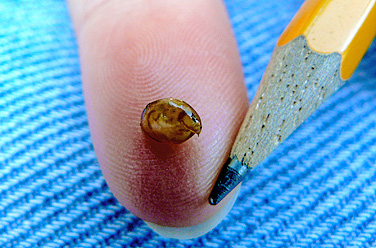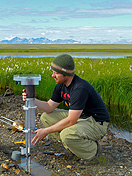News
Unexpected crustacean diversity
discovered in freshwater ecosystems

A tiny crustacean, called Eurycercus, from an Alaskan pond. A study suggests that threatened northern freshwater ecosystems harbor a significant proportion of these creatures’known species diversity.
-
 Print
Print -
 Comments
Comments
-

UB graduate student Matthew Ballinger helps to prepare sediment cores from a small lake on the Alaskan tundra that contains a new species of the crustacean Eurycercus.
Freshwater ecosystems in northern regions are home to significantly more species of water fleas than traditionally thought, adding to evidence that regions with vanishing waters contain unique animal life.
The new information on water fleas—which are actually tiny crustaceans—comes from a multi-year, international study that was published last month in the journal Zootaxa.
The researchers scoured the globe seeking the creatures and found them inhabiting northern lakes and ponds in locations from Alaska to Russia to Scandinavia.
After analyzing the anatomy and genetic makeup of many different specimens, the team conclusively determined that at least 10 species of the crustaceans existed—five times as many as thought for much of the last century.
More than half the diversity was found in northern latitudes, where rapid freshwater habitat loss is occurring due to melting permafrost, increased evaporation and other changes tied to climate change.
“It is well known that parts of Alaska and Siberia have suffered a huge reduction in freshwater surface area, with many lakes and ponds disappearing permanently in the past few decades,” says Derek J. Taylor, a UB biologist and member of the research team. “What we’re now finding is that these regions with vanishing waters, while not the most diverse in the world, do contain some unique aquatic animals.”
“Some of these subarctic ponds that water fleas inhabit are held up by permafrost, so when this lining of ice melts or cracks, it’s like pulling the plug out of a sink,” Taylor says. “When you see the crop-circle-like skeletons of drained ponds on the tundra, you can’t help but wonder what animal life has been lost here.”
Taylor’s colleagues on the study included Eugeniya I. Bekker and Alexey A. Kotov of the A. N. Severtsov Institute of Ecology and Evolution in Moscow.
The research focused on water fleas of the genus Eurycercus, which can reach lengths of about 6 millimeters. The findings add to a body of evidence suggesting that the species diversity of water fleas is greater in northern regions than in the tropics.
This is a counterintuitive concept, as scientists have long supposed that the advance and readvance of ice sheets reduced much of the species diversity in colder climates, Taylor explains. However, there is growing evidence that some northern areas remained ice-free and acted as hideouts during the harsh glacial advances.
The researchers not only convincingly documented new species diversity, but identified one likely new species and provided a detailed, formal description of another: Eurycercus beringi.
Like other water fleas, E. beringi is an important source of nutrients for fish and aquatic birds.
The new species—from Alaska’s remote Seward Peninsula—has unusual anatomical features that force a rewrite of the taxonomy of Eurycercus above the species level. Moreover, the new anatomical details should aid future studies that use preserved body parts of Eurycercus found in lake sediments to reconstruct past ecological conditions.
The discovery of new crustacean species in unexpected places underscores the scope of the ongoing biodiversity crisis for freshwater ecosystems.
The research was supported by the Biodiversity Program of the Presidium of Russian Academy of Sciences, the Russian Science Support Foundation, the Russian Foundation for Basic Research, the Smithsonian Institution Office of Fellowships and the National Science Foundation.

Reader Comments